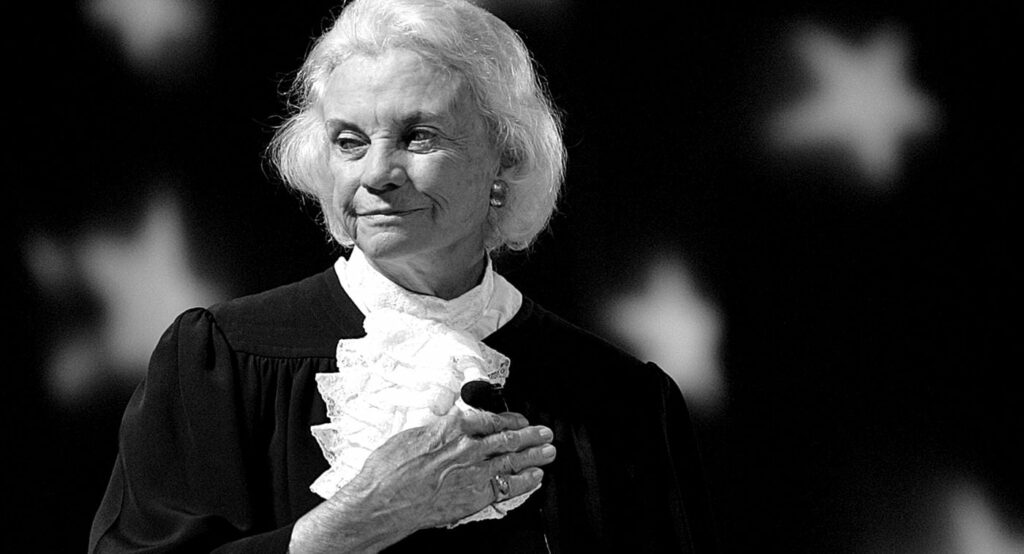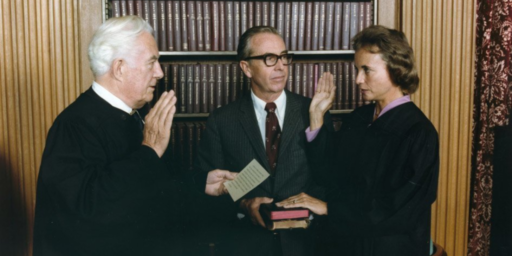Sandra Day O’Connor and Bush v Gore
New documents reveal the internal deliberations of the Court.

Under the weird headline “New documents show how Sandra Day O’Connor helped George W. Bush win the 2000 election,” CNN’s Joan Biskupic sheds new light on one of the most controversial cases in Supreme Court history.
Justice Sandra Day O’Connor provided the early framework that steered the outcome in the dispute over the 2000 presidential election and ensured George W. Bush would win the White House over Al Gore, Supreme Court documents released on Tuesday show.
Memos found in the newly opened files of the late Justice John Paul Stevens offer a first-ever view of the behind-the-scenes negotiations on Bush v. Gore at the court. They also demonstrate the tension among the nine justices being asked to decide a presidential election on short deadlines.
The documents opened at the Library of Congress help reveal how the now-retired O’Connor, the first woman on the high court and a justice steeped in politics from her early days in the Arizona legislature, partnered with Justice Anthony Kennedy, effectively squeezing out an argument advanced by then-Chief Justice William Rehnquist.
The strong hand of O’Connor, who was at the ideological center of the court in this era, is not wholly surprising. O’Connor was also known for trying to get out ahead of deliberations, and her four-page memo was circulated to colleagues even before oral arguments. Her move may have guaranteed that she and Kennedy had the greatest influence on the final “per curiam” opinion that spoke for a five-justice majority.
There’s a lot in the report rehashing the external political fight over the Florida recount but anyone reading this will be quite familiar with that. What’s new here is the internal struggle among the Justices over the ruling.
O’Connor’s views, expressed in a December 10, 2000, memo, were endorsed by fellow conservative-centrist Kennedy as he took the lead in writing the unsigned “per curiam” opinion issued late on the evening of December 12, the new documents show.
The shared views of O’Connor and Kennedy eventually forced Rehnquist to abandon his effort to author the main opinion with a boundary-pushing view of federal election principles – views that would come up during Donald Trump’s attempt to overturn the 2020 presidential election.
So, what O’Connor contributed was a different theory of why the vote counting must stop than the one Rehnquist was pushing. Either way, the majority agreed that what was happening in Florida was in violation of the Constitution.
O’Connor laid the groundwork for that result in her December 10 memo to all her colleagues as she condemned a Florida state Supreme Court decision ordering selective recounts of “undervotes” in certain counties.
She opened by highlighting state legislative authority to set the rules for the appointment of state presidential electors but quickly focused on the flaws, as she perceived them, of the ongoing recounts ordered by the state court.
“The Florida Supreme Court provided no uniform, statewide method for identifying and separating the undervotes,” O’Connor wrote, referring to instances when machines had failed to detect a vote for president. “Accordingly, there was no guarantee that those ballots deemed undervotes had not been previously tabulated. More importantly, the court failed to provide any standard more specific than the ‘intent of the voter’ standard to govern this statewide undervote recount. Therefore, each individual county was left to devise its own standards.”
The system triggered by the Florida Supreme Court “in no way resembles the statutory scheme created by the Florida legislature” for the appointment of electors, said the justice who had once served as Arizona state Senate majority leader, the first woman nationwide to hold such the top post in a state senate.
The next day, Kennedy wrote to the chief justice, “Sandra’s memorandum sets forth a very sound approach” and said he wanted to build on it. He suggested he would point up how the varying recount practices breached the guarantee of equal protection.
The correspondence in the Stevens files suggests that Rehnquist thought he might be able to work with Kennedy on the court’s main opinion and to press the chief’s own theory of complete and independent state legislative power.
Rehnquist wrote in a December 11 memo that he and Kennedy were “working on a composite opinion.” Rehnquist hoped to send around a copy that evening.
By the next day, however, Kennedy had fully separated himself from Rehnquist’s view of complete state legislative authority over presidential elections with no check by a state judges interpreting the state’s constitution.
As a result, Rehnquist wrote to the group, his own “present draft cannot accurately be labeled” the opinion for the court. Rehnquist said he would be re-circulating his views, going beyond the O’Connor-Kennedy position, as a separate concurring opinion.
The Rehnquist view, backed only by Scalia and Thomas, would have given new power to state legislatures to control presidential election battles. Under this “independent state legislature” theory – which was revived by Trump supporters in 2020 and is at the heart of a pending North Carolina dispute – state courts lack the authority to find that a state legislature’s electoral practices violate the state’s constitution.
Kennedy had foreshadowed his reluctance to accept that theory during the Bush v. Gore oral arguments. “It seems to me essential to the republican theory of government that the constitutions of the United States and the states are the basic charter, and to say that the legislature of the state is unmoored from its own constitution, and it can’t use its court … (is) it seems to me a holding which has grave implications for our republican theory of government.”
O’Connor, similarly breaking from the Rehnquist view, wrote Kennedy a note on December 12 that she would join his per curiam opinion.
We’ve previously discussed Rehnquist’s theory here at length (see, “Independent State Legislature Theory” and “Rehnquist and the ‘Independent State Legislature’ Theory“). While I had been aware that this was the position he took in his concurring opinion, I don’t believe that I had previously seen that it had been the prevailing theory of the majority prior to O’Connor and Kennedy steering it to a much more narrow basis.
While we could tell from the dissents by the liberal justices that the ruling sparked considerable tension among the Justices, the newly released documents provide new insights into just how bitter the dialog was.
“Going home after a long day,” Scalia wrote to fellow justices when it was all over on December 12, “I cannot help but observe that those of my colleagues who were protesting so vigorously that the Court’s judgment today will do it irreparable harm have spared no pains – in a veritable blizzard of separate dissents – to assist that result. Even to the point of footnote 4 in Ruth’s offering (I call it the Al Sharpton footnote), alleging on the basis of press reports ‘obstacles to voting disproportionately encountered by black voters.’”
Well-known for his take-no-prisoners dissenting views, Scalia added, “I am the last person to complain that dissents should not be thorough and hard-hitting (though it would be nice to have them somewhat consolidated). But before vigorously dissenting (or, come to think of it, at any other time) I have never urged the majority of my colleagues to alter their honest view of the case because of the potential ‘damage to the Court.’ I just thought I would observe the incongruity. Good night.” He signed it, “Sincerely, Nino.”
In their opinions, liberal dissenters had emphasized the cost to the court as an institution and, in Breyer’s words, “damage” to the country.
Similarly, Kennedy wrote to colleagues that same day, “I do not usually respond to dissenting opinions, and will not do so for the per curiam in this case. I take the occasion in this memo, however, to say that the tone of the dissents is disturbing both on an institutional and personal level. I have agonized over this and made my best judgment. Some of the dissenters in fact agree on the equal protection point, but take great pains to conceal that agreement. The dissents, permit me to say, in effect try to coerce the majority by trashing the Court themselves, thereby making their dire, and I think unjustified, predictions a self-fulfilling prophecy.”





In light of these revelations, there should be more discussion about the Newsweek article at the time.
@Kylopod: In fairness, she didn’t retire until 2006—halfway through Bush’s second term.
SCOTUS justices are humans and thus follow the same decision-making process as most humans: conclusion first, followed by rationalization.
Every conservative justice now on the court lied under oath to Congress. Every single one. They lied about their respect for precedent, pretending that they wouldn’t leap at an opportunity to impose their religious opinions on all of us. Indeed, they were carefully briefed on how to lie by political partisans. And we pretend it’s OK and tell ourselves it’s all about interpreting the constitution.
It is axiomatic that conservatives lie. They lie about everything from their supposed concerns about debt, to their bullshit about how they’d never use the law to punish women who had abortions. If God is on your side, anything is permissible.
@James Joyner:
Yes, I’m aware of that. And it’s worth mentioning that she has persistently denied the Newsweek report is accurate. I don’t believe her, but you can take from that what you will. And it’s quite possible the reason she didn’t retire during Bush’s first term was because she knew how bad it would look. And who knows, maybe she even harbored some guilt and felt too sleazy to take that step until Bush won legitimately. (She did later say she regretted her vote in Bush v. Gore.) Whatever her motivations, it doesn’t absolve her in my mind.
@Michael Reynolds: Every conservative justice now on the court lied under oath to Congress. Every single one. They lied about their respect for precedent, pretending that they wouldn’t leap at an opportunity to impose their religious opinions on all of us. Indeed, they were carefully briefed on how to lie by political partisans.
@Michael Reynolds:
And about how tax cuts for rich create growth that “trickle down” to middle and working classes, how climate change science isn’t real, how Fox News is fair and balanced, how they are textualists and originalists, how pre-viability abortion doesn’t have a long tradition in the US, how they believe in local control, how Trump didn’t collude with Russia, how whites are the real victims of racism, how J6 was a peaceful protest, how crime in blue states and cities is out-of-control, how the 2nd Amendment provides a right for any nutjob to buy AR-15s without sensible controls, how mass voter fraud is costing them elections, how drag queens and Disney are a bigger threat to children than the ongoing barrage of literal GQP pedos and perverts, and on and on.
At least conservatives still tell the truth about the general need to secure the border and the counterproductivity of vaccine mandates. So. That’s two I guess.
Florida had left voting methods and equipment largely up to local control and in 2000 various counties used various methods. The Equal Protection clause was clearly intended to make freed Blacks equal under the law. Claiming the clause meant ballots suddenly had to be treated equally was bizarre, hence the declaration that it wasn’t precedent.
What @Michael Reynolds: said, conclusion first, rationalization to follow. I suppose we should be grateful they didn’t stick us with the equally bizarre, and potentially far worse, rationalization of the independent state legislature theory. Which may yet become an undead zombie idea. Both rationalizations are examples of “originalism”. The Founders, or the post Civil War congress, wrote a clause that on its face means A. But if we hold the light just right and cherry-pick a little history we can pretend it means B. And we’re the Supremes, so whatcha gonna do about it?
@DK: I’ve long said that Ds lie less than Rs. Not because they’re better people, but because they don’t have to. If you want to act to reduce AGW there is a long list of true arguments you can use. If you want to not do anything, you have to lie. The beauty thing about liberalism is that liberal pols can do well by doing good. What conservatives are selling cannot be sold without lying.
There’s a difference between deception and self-deception. Obama was deceiving the public about gay marriage when he ran for President and the deception may have been necessary to win (I don’t think it was) but it was still deception.
On the other side, Clarence Thomas is almost certainly guilty of perjury regarding Anita Hill, and I suspect many moderate Republicans who supported him at the time believe this now. But they can’t admit to themselves, because of the domino effect of about 1000 acts of self-deception. The same problem probably grasp that the decision to stop the counting the votes in 2020 was an authoritarian act, but they can’t admit that either. It goes for racism—I mean, Scalia with his chain email uncle Al Sharpton bigotry on display is just something that Republicans will bury in their minds—and everything else. Self-deception is really the defining feature of the Republican party and it’s why we have Trump.
@Modulo Myself: Dinesh D’Souza got convicted for campaign finance violations on behalf of the Republican challenging Kirsten Gillibrand in the 2012 Senate race in New York, in a race she went on to win by 45 points. I mention this because I have generally conceptualized D’Souza as a liar rather than an idiot. But his crime was so bafflingly pointless it’s led me to rethink my notions of how far some of these people are trapped in their own bubbles. My usual habit over the years has been to picture them doing a villainous cackle the moment the cameras are turned off. The Dominion transcripts have certainly lent support to that assumption. But that doesn’t mean there isn’t self-deception involved in at least some of the things they do.
It is my recollection that Amy Coney Barrett did not lie, at least not about Roe, to get on the court. Susan Collins didn’t vote to confirm her, after all.
The Justices that Collins pointed out as doing something that is completely inconsistent with what they said to her were Kavanaugh and Gorsuch.
Politics involves lying. It also involves redirecting attention, which is not at all the same thing as lying. Elected officials are going to lie at times. It’s part of the job. And candidates for those jobs will obfuscate, redirect, and sometimes lie. When they speak of things that they want to do in office, though, they usually mean it. (James K. Polk being a very notable exception).
However, we do not expect the same from Justices. Bush v. Gore started the slide of respect for the Court and nothing in the intervening years has reversed it.
I feel pretty confident at this point that this stuff will be undone at some point in the future. The wheel always turns. Abortion rights are now a front-and-center issue not just for the religious right, but for a whole bunch of other people who thought it was settled.
I long remember Republicans claiming that with Roe, the Court settled an issue that should be settled politically. Well, now we get to settle it politically, and that may not turn out like they thought. In turn, we see people saying things, “You don’t vote on right and wrong”. Which marks them as enemies of democracy and enemies of the United States of America. I think we can easily highlight such attitudes as traitorous.
@Jay L Gischer:
I think we can all agree this has had negative consequences. But belief in the Court’s impartiality was always a comfortable lie, and it wasn’t cost-free. It used to be considered normal for Senators to vote to confirm a president’s nominee unless there was a very good reason not to. For instance, Scalia was confirmed unanimously–every Democrat and every Republican in the Senate voted to put him on the Court. When Thomas got appointed by a razor-thin 52-48, that was highly unusual at the time and was almost entirely due to the Anita Hill matter, not to his ideological views. And even then he got a bunch of Democratic votes. The situation today where everything’s near-party-line would have seemed baffling even by then.
Yet presidents did try to choose nominees who were similar to them ideologically. This didn’t always end up working, as David Souter can attest, but at least the attempt was made. So it was an asymmetric situation where the president got a chance to remake the Court in his image, but Senators were expected to rubber-stamp it regardless of their own ideological or partisan preferences. And blind luck was still a factor–Jimmy Carter was president for the same amount of time as Donald Trump, yet he never got a chance to appoint a SCOTUS justice, whereas Trump got three, who all will be on the Court for decades now, probably long after Trump himself is dead.
I don’t believe this was ever a good situation. And please, nobody give me any crap about the wisdom of the Founders–they didn’t have a clue about the impact of political parties. And part of the reason we are where we are right now is because RBG didn’t engage in strategic retirement, like Kennedy or O’Connor. And part of the reason she didn’t is because she still felt bound to those fictitious and now-outdated norms.
@Kylopod: that’s a bit of a cover story for RBG there. She more seemed to be disappointed by Obama having the temerity to beat out Hillary in the primary and hoping for a Hillary win in 2020 for the symbolism of her replacement being nominated by her. It had little to do with, “norms”.
There is so much too dislike about the opinion but instead of going point by point I will just say that when the opinion states itself that it’s has no precedential value that says it all.
@Thomm: Lot to spend on becoming a feminist icon. Very costly.
IMO Justice Ginsburg should have known the odds of a Democrat other than Obama nominating her successor were low.
To begin with, it’s rare for either party to hold the White House more than two terms. Offhand the only relatively recent instances I can recall is Roosevelt and Truman (for an awfully long time), and Reagan and Bush the elder.
To continue, by 2014 she was already 81 and had survived a bout of cancer. Her odds of surviving to 2021 were low, and had anyone other than Benito won in 2016 (which was the way to bet in 2014), she might have had to hold on until 2025. The odds for that were infinitesimal.
@Kathy:
You’re engaging in election-nerd analysis, something the justices aren’t necessarily well-versed in. For instance, did anyone notice in the article I quoted earlier, Sandra Day O’Connor considered Illinois one of the key swing states in the 2000 election?
The conservative bench was absolutely right that it was absurd to allow the recount to go on in some counties — mostly Democratic — but not others. That decision should have been 9-0 instead of 7-2. The 5-4 decision to stop the count completely is less well-grounded.